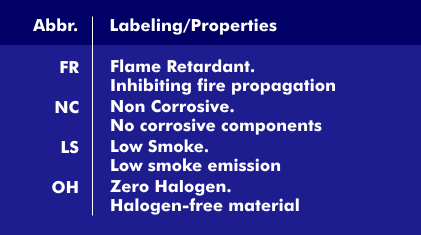fire behavior
The fire behavior of data cables is of fundamental importance in the selection of cables for indoor and outdoor use, with the fire load, smoke-gas development and fire propagation being the determining factors for fire behavior. Decisive for the fire behavior are the cable materials used for the sheathing.
Until a few years ago, PVC-sheathed( polyvinyl chloride) cables were almost exclusively used for data networks. However, the polyvinyl chloride (PVC) releases toxic and corrosive hydrogen chloride in the event of a fire. In addition, there is a strong emission of smoke, which poses a risk of poisoning to humans. In order to reduce toxic gas formation in the event of a fire, halogen-free materials are predominantly used in newer installations.
Another important criterion is fire propagation. Flame-retardant cables are cables that continue to burn only for a short time and over a short distance after the pilot flame has been removed, and then extinguish by themselves. The fire behavior of cables is specified in various international standards, EU and national standards. Standards 60332-x issued by theInternational Electrotechnical Commission( IEC), the Comité Européen de Normalisation Electrotechnique( CENELEC) and DIN define corrosivity, flame resistance, burning behavior, smoke density and insulation integrity.
For the production of data cables, electrically high-quality insulation materials must be used. As a rule, these are flammable and combustible materials, mainly polyethylene, in foamed or non-foamed versions. The design structure, in particular the cable sheath, its thickness and material, therefore largely determine the flame resistance of the cable.
Cable manufacturers identify the properties by abbreviations: Flame Retardant( FR) stands for delayed fire propagation, Low Smoke( LS) for low smoke emission, Non Corrosive( NC) denotes cables that have no corrosive components and No Halogen ( OH) or Zero Halogen (ZH), denotes cables with halogen-free material. When selecting cables, those with sheaths made of halogen-free copolymer are preferable, as no corrosive gases are produced in the event of a fire, the smoke density is considerably lower and the proportion of toxic gases is significantly reduced.
Standards for fire testing: IEC 60332-x. With IEC standards 60332-1, 60332-2 and 60332-3, there are three standards with different test requirements for fire propagation and fire spread in individual cables and cable bundles. The cable bundle test represents more stringent requirements for the flame resistance of the cable sheath.

